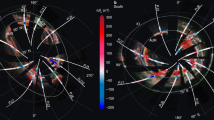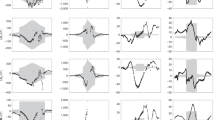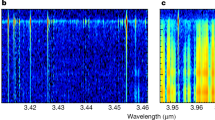Abstract
Our understanding of Jupiter’s magnetic field has been developed through a combination of spacecraft measurements at distances >1.8RJ and images of the aurora1,2,3,4,5,6,7. These models all agree on the strength and direction of the Jovian dipole magnetic moments, but because higher-order magnetic moments decay more strongly with distance from the planet, past spacecraft measurements could not easily resolve them. In the past 2 years, the Juno mission has measured very close to the planet (>1.05RJ), observing a strongly enhanced localized magnetic field in some orbits8,9, and resulting in models that identify strong hemispheric asymmetries at mid-to-high latitudes10,11. These features could be better resolved by identifying changes in the ionospheric density caused by interactions with the magnetic field, but past observations have been unable to spatially resolve such features12,13,14. In this study, we identify a dark sinusoidal ribbon of weakened H3+ emission near the jovigraphic equator, which we show to be an ionospheric signature of Jupiter’s magnetic equator. We also observe complex structures in Jupiter’s mid-latitude ionosphere, including one dark spot that is coincident with a localized enhancement in Jupiter’s radial magnetic field observed recently by Juno10. These features reveal evidence of complex localized interactions between Jupiter’s ionosphere and its magnetic field. Our results provide ground-truth for Juno spacecraft observations and future ionospheric and magnetic field models.
This is a preview of subscription content, access via your institution
Access options
Access Nature and 54 other Nature Portfolio journals
Get Nature+, our best-value online-access subscription
$29.99 / 30 days
cancel any time
Subscribe to this journal
Receive 12 digital issues and online access to articles
$119.00 per year
only $9.92 per issue
Buy this article
- Purchase on Springer Link
- Instant access to full article PDF
Prices may be subject to local taxes which are calculated during checkout


Similar content being viewed by others
References
Smith, E. J. et al. The planetary magnetic field and magnetosphere of Jupiter: Pioneer 10. J. Geophys. Res. 79, 3501–3513 (1974).
Smith, E. J. et al. Jupiter’s magnetic field, magnetosphere, and interaction with the solar wind—Pioneer 11. Science 188, 451–455 (1975).
Connerney, J. E. P. The magnetic field of Jupiter—a generalized inverse approach. J. Geophys. Res. 86, 7679–7693 (1981).
Connerney, J. E. P., Acuña, M. H., Ness, N. F. & Satoh, T. New models of Jupiter’s magnetic field constrained by the Io flux tube footprint. J. Geophys. Res. 103, 11929–11940 (1998).
Connerney, J. E. P. Treatise on Geophysics Vol. 10 (eds Schubert, G. & Spohn, T.) (Elsevier, Oxford, 2007).
Grodent, D. et al. Auroral evidence of a localized magnetic anomaly in Jupiter’s northern hemisphere. J. Geophys. Res. 113, A09201 (2008).
Hess, S. L. G., Bonfond, B., Zarka, P. & Grodent, D. Model of the Jovian magnetic field topology constrained by the Io auroral emissions. J. Geophys. Res. 116, A05217 (2011).
Bolton, S. J. et al. Jupiter’s interior and deep atmosphere: the initial pole-to-pole passes with the Juno spacecraft. Science 356, 821–825 (2017).
Connerney, J. E. P. et al. Jupiter’s magnetosphere and aurorae observed by the Juno spacecraft during its first polar orbits. Science 356, 826–832 (2017).
Moore, K. M., Bloxham, J., Connerney, J. E. P., Jørgensen, J. L. & Merayo, J. M. G. The analysis of initial Juno magnetometer data using a sparse magnetic field representation. Geophys. Res. Lett. 44, 4687–4693 (2017).
Connerney, J. E. P. et al. A new model of Jupiter’s magnetic field from Juno’s first nine orbits. Geophys. Res. Lett. 45, 2590–2596 (2018).
Stallard, T. S. et al. Cassini VIMS observations of H3 + emission on the nightside of Jupiter. J. Geophys. Res. 120, 6948–6973 (2015).
Lam, H. A. et al. Baseline spectroscopic study of the infrared auroras of Jupiter. Icarus 127, 379–393 (1997).
Miller, S. et al. Mid-to-low latitude H3 + emission from Jupiter. Icarus 130, 57–67 (1997).
Shure, M. A., Toomey, D. W., Rayner, J. T., Onaka, P. M. & Denault, A. J. NSFCAM: a new infrared array camera for the NASA Infrared Telescope Facility. Instrum. Astron. VIII 2198, 614–622 (1994).
Johnson, R. E., Stallard, T. S., Melin, H., Miller, S. & Nichols, J. D. Measurements of the rotation rate of the Jovian mid-to-low latitude ionosphere. Icarus 280, 249–254 (2016).
Stallard, T. S. et al. The Great Cold Spot in Jupiter’s upper atmosphere. Geophys. Res. Lett. 44, 3000–3008 (2017).
Fletcher, L. N. et al. Mid-infrared mapping of Jupiter’s temperatures, aerosol opacity and chemical distributions with IRTF/TEXES. Icarus 278, 128–161 (2016).
O'Donoghue, J., Moore, L., Stallard, T. S. & Melin, H. Heating of Jupiter’s upper atmosphere above the Great Red Spot. Nature 536, 190–192 (2016).
Melin, H. & Stallard, T. S. Jupiter’s hydrogen bulge: a Cassini perspective. Icarus 278, 238–247 (2016).
Achilleos, N. et al. JIM: a time-dependent, three-dimensional model of Jupiter’s thermosphere and ionosphere. J. Geophys. Res. 103, 20089–20112 (1998).
Hanson, W. B. & Moffett, R. J. lonization transport effects in the equatorial F region. J. Geophys. Res. 71, 5559–5572 (1966).
Rayner, J. T., Cushing, M. C. & Vacca, W. D. The Infrared Telescope Facility (IRTF) spectral library: cool stars. Astrophys. J. Suppl. Ser. 185, 289–432 (2009).
Acknowledgements
This work was supported by the UK STFC Consolidated Grant ST/N000749/1 (to H.M. and T.S.S.) and a PhD studentship (to R.E.J.). A.G.B. was supported by NERC grant NE/K011766/1 and the start-up funds provided to R. Stoneback by the University of Texas at Dallas. L.N.F. was supported by a Royal Society Research Fellowship at the University of Leicester. L.M. was supported by NASA under grant NNX17AF14G issued through the SSO Planetary Astronomy Program. J.E.P.C. and T.S. were visiting astronomers at the NASA Infrared Telescope Facility, which is operated by the University of Hawaii under Cooperative Agreement NNX-08AE38A with the National Aeronautics and Space Administration Science Mission Directorate Planetary Astronomy Program.
Author information
Authors and Affiliations
Contributions
T.S.S. led the project, performed data reduction and data analysis, produced the figures, and wrote the paper. A.G.B. performed equatorial modelling for Earth comparison, took part in detailed discussions and co-wrote the section on magnetic field interactions. H.M. performed data analysis, including image processing and limb fitting. L.N.F. performed data analysis on tropospheric emission and discussed the troposphere. S.M. discussed the data analysis techniques. L.M. took part in detailed discussions of Jupiter’s ionosphere and co-wrote the section on the ionosphere. J.O. discussed ionospheric darkening and comparisons with Saturn. J.E.P.C. was project leader for the original observations, performed data reduction, and discussed in detail the magnetic field modelling. T.S. was an observer, took part in detailed discussion of the instrumental errors, and led the discussion on testing of the image-processing technique. R.E.J. discussed the data analysis techniques. All authors reviewed and edited the manuscript.
Corresponding author
Additional information
Publisher’s note: Springer Nature remains neutral with regard to jurisdictional claims in published maps and institutional affiliations.
Supplementary information
Supplementary Information
Supplementary Figures 1–9, Supplementary text, Supplementary reference
Rights and permissions
About this article
Cite this article
Stallard, T.S., Burrell, A.G., Melin, H. et al. Identification of Jupiter’s magnetic equator through H3+ ionospheric emission. Nat Astron 2, 773–777 (2018). https://doi.org/10.1038/s41550-018-0523-z
Received:
Accepted:
Published:
Issue Date:
DOI: https://doi.org/10.1038/s41550-018-0523-z
This article is cited by
-
Jupiter Science Enabled by ESA’s Jupiter Icy Moons Explorer
Space Science Reviews (2023)



